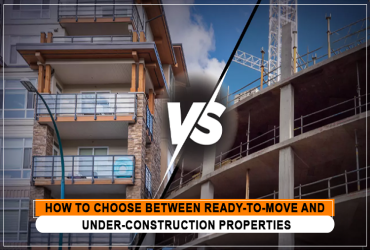
The decision to purchase a home is one of life's most significant financial commitments. Among the many choices buyers face, one of the most critical is investing in a ready-to-move-in property or an under-construction one. Both options have advantages and drawbacks, and the right choice depends on your priorities, long-term goals, and financial situation. This blog explores every aspect of these two property types to help you make an informed decision.
Understanding Ready-to-Move and Under-Construction Properties
Ready-to-Move-In Properties
Ready-to-move-in properties a homes that are fully constructed, available, and completed for immediate possession. Buyers can inspect the property, evaluate its quality, and move in as soon as the purchase is finalized.
An under-construction property refers to a home that is still in the process of being built. Buyers typically invest in such properties at different stages of construction, often based on architectural plans or model homes.
Key Factors to Consider
1. Cost
Ready-to-Move-In Properties: These homes generally have higher upfront costs because they include completed infrastructure, market appreciation, and amenities. Buyers must pay the full amount, including stamp duty and registration charges, at once.
Under Construction Properties: These are usually more affordable at he time of booking, as developers often offer discounts or incentives during the construction phase. Payment is typically made in installments aligned with construction milestones, reducing immediate financial strain.
2. Possession Timeline
Ready-to-Move-In Properties: The biggest advantage is immediate possession. Buyers can move in as soon as the purchase formalities are completed, making it ideal for those who need a home urgently.
Under Construction Properties: These come with longer wait times, often ranging from 2 to 5 years. Delays due to regulatory approvals, labor shortages, or financial issues are common and can significantly disrupt plans.
3. Customized
Ready-to-Move-In Properties: These offer limited or no customized options since they are already completed. Buyers looking for a personal touch may find this restrictive.
Under Construction Properties: One of the biggest advantages is the ability to customize layouts, finishes, and interiors according to personal preferences.
4. Legal Risks
Ready-to-Move-In Properties: These usually come with fewer legal risks since all necessary approvals are already in place. However, buyers must still verify ownership documents to avoid fraud.
Under Construction Properties: It requires thorough due diligence on the developer’s reputation and project approvals. Regulatory compliance issues or disputes over land ownership can lead to significant risks.
5. Payment Structure
Ready-to-Move-In Properties: Buyers must arrange for full payment upfront or through a home loan. This includes down payments, stamp duty, registration charges, and other costs all at once.
Under Construction Properties: Payments are phased according to construction progress, making it easier for buyers to manage their finances over time. This flexibility can be particularly beneficial for those relying on loans or mobilized savings.
Pros and Cons
Pros of Ready-to-Move Properties
|
Immediate possession eliminates waiting periods. |
No risk of delays or changes in project specifications. |
|
Lower legal risks due to completed documentation. |
Ideal for those seeking immediate housing solutions. |
Cons of Ready-to-Move Properties
|
Higher initial cost compared to under-construction homes. |
Limited options for customization. |
|
Requires full payment options. |
Potentially inflated prices due to market appreciation. |
Pros ofhttps://countryroof.in/
|
Lower entry cost with flexible payment plans. |
Opportunity for customization. |
|
Higher appreciation potential over time. |
Newer infrastructure with modern amenities. |
Cons of Under-Construction Properties
|
Risk of delays in possession. |
Uncertainty regarding quality or final design. |
|
Additional hidden costs, like maintenance fees during construction delays. |
Legal risks if the developer fails regulations or cancels the project altogether. |
Who Should Choose What?
Choose Ready-to-Move if you:
-
Need immediate housing without delays.
-
Certainly prefer regarding what you are buying.
-
Have sufficient funds or loan approval for the upfront payment.
-
They are risk-averse and want minimal legal complications.
Choose Under-Construction if you:
-
Are you looking for a more affordable option with phased payments?
-
Want customization options for your home?
-
Can wait several years before moving in.
-
Are willing to take calculated risks for higher investment returns.
Conclusion
Choosing between ready-to-move-in and under-construction properties boils down to your priorities. You may value immediate possession and certainty or affordability and customization potential with some risk tolerance.




3 Comments